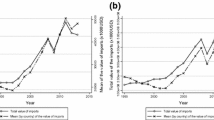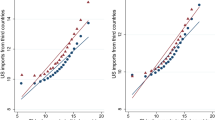Abstract
This contribution evaluates determining factors of Specific Trade Concerns (STCs) raised on Technical Barriers to Trade (TBT) notifications over the period 1995–2011. While multilateral and international agreements bind countries concerning the imposition of tariffs on imports, TBTs have been used as trade policy instruments, which conceal the true motivations of governments. The main legitimate reasons behind the imposition of TBTs are to increase environmental qualities and human health, or to improve market efficiencies. However, in addition to these reasons, governments are also in pursuit of protecting their domestic industries. In fact, this contribution analyses how trade protectionist motives and legitimate public policy objectives induce these specific trade measures. Various effective factors of TBT STC notifications are considered in the econometric analysis using fixed effect Poisson estimation as the main technique, and Poisson GMM as robustness specification. Separate estimations on the European Union block in this study points at the determining factors of TBTs harmonized by heterogeneous member states. Results suggest that bilateral trade and tariffs are one of the forces of TBT STC notifications, acknowledging the protectionist behaviour of authorities. Moreover, countries with high quality of humans’ health-related environmental issues, and low environmental vitalities, are more likely to impose new TBTs. Overall, this study confirms the complex nature of TBT STCs affected by economic, technological, institutional, and health and environmental issues.


Similar content being viewed by others
Notes
World Integrated Trade Solution (WITS), 2012.
For example on 20 March 2001, Peru requested for consultation with the European Community (EC) regarding the EU regulation on sardines imports (DS231), which can be also traced as item number 87 within the TBT STC dataset with the emphasis on being an unnecessary barrier to trade. Another example is three DS cases on certain measures imposed by the EU prohibiting the importation and marketing of seal products (DS369, DS400, and DS401) that are also traceable within the TBT STC notifications (item numbers 112, 188, and 222). These DS cases can be found here: https://www.wto.org/english/tratop_e/dispu_e/dispu_agreements_index_e.htm?id=A22#.
Documentations can be found at: http://www.wto.org/english/tratop_e/dispu_e/cases_e/ds381_e.htm.
Documentations can be found at: http://www.wto.org/english/tratop_e/dispu_e/cases_e/ds293_e.htm.
The data on some variables cover only this period. However, estimations on a larger sample for the period 1995-2011 are additionally presented in the "Appendix".
In this analysis, the country imposing the TBT is accounted for as the Reporter country, and the concerned member is referred to as the Partner country.
For instance in 2010, based on Environmental Vitality (EV) index, discussed below, Latvia has the best environmental quality with the score of 68.90, and Malta has the lowest environmental quality with the score of 30.05 amongst all EU members. While in the Parliament these countries have little power due to their small size, based on their differences in environmental qualities, they might vote for different spectrums of trade policies affecting the environment. Similar statements for other indicators can be brought to show the role of heterogeneous EU countries in shaping the trade policies.
It is important to mention that, wherever the original database refers to the European Union as the maintaining or concerned member, depending on the year of the notifications, individual Member States at the time are accounted for.
Information regarding this database can be found at: http://wits.worldbank.org/wits/.
It would be better to control for the number of products (CN8) traded by each country pair, rather than for the total number of products within each 2-digit category. However, there are no available data for that issue and here in this study, the number of CN8 products is included to mainly control for some product level effects.
Instead of inflation, it seems more sensible to include bilateral exchange rates among the regressors. However, lack of available data on exchange rates would shrink the estimated sample by more than half, which also changes the estimation results of some regressors dramatically. The estimations with bilateral exchange rates instead of the deflator are available on request.
Information regarding this database can be found at: http://www.systemicpeace.org/polity/polity4.htm.
Data on RQ are available for the period 1996–2011, but values for 1997, 1999 and 2001 are missing. A simple average of data from adjacent years (at most one year earlier and one year later) is interpolated for these missing years.
Information regarding these data can be found at:/.
Here, it can be mainly assumed that the bound tariff is held constant, because generally bound tariffs are commitments within WTO for a long period.
The remaining number of observations in the panel shows that two-thirds of the whole sample cover EU reporter countries. This is mainly because of the dropping out of time-invariant observations in the dependent variable. However, in the pooled sample regression, presented in Table 7 in the “Appendix”, a reverse situation is observed.
It is worth mentioning that partner countries are not classified separately in these regressions.
A set of estimation results on the EU sample as a single economy is available upon request. This specification includes country-level variables for the whole EU calculated as the simple average over all individual members. Taking the simple average and not controlling for the size of individual countries in the EU policymaking, some of the EU-level variables become statistically significant in this specification. This suggests that public policy objectives at the EU-level as a whole motivate the TBT STCs maintained by the EU, while the results over the sample of individual EU members in Table 3 did not suggest it.
References
Aisbett E, Pearson L (2013) Environmental and Health Protections, or new protectionism? determinants of SPS notifications by WTO members. Determinants of SPS notifications by WTO members (NO. 1213). Crawford School Research Paper
Balassa B (1965) Trade liberalisation and ‘revealed’ comparative advantage. Manch Sch 33(2):99–123
Beghin J, Disdier AC, Marette S, Van Tongeren F (2012) Welfare costs and benefits of non-tariff measures in trade: a conceptual framework and application. World Trade Rev 11(03):356–375
Blonigen BA, Bown CP (2003) Antidumping and retaliation threats. J Int Econ 60(2):249–273
Broda C, Limao N, Weinstein DE (2008) Optimal tariffs and market power: the evidence. Am Econ Rev 98(5):2032–2065
de Almeida FM, da Cruz Vieira W, da Silva OM (2012) SPS and TBT agreements and international agricultural trade: retaliation or cooperation? Agric Econ 43(2):125–132
Edward M, Milner H, Rosendorff P (2002) Why democracies cooperate more: electoral control and international trade agreements. Int Org 56(3):477–513
Ernst D, Lee H, Kwak J (2014) Standards, innovation, and latecomer economic development: conceptual issues and policy challenges. Telecommun Policy 38(10):853–862
Essaji A (2008) Technical regulations and specialization in international trade. J Int Econ 76(2):166–176
Feinberg RM, Reynolds KM (2006) The spread of antidumping regimes and the role of retaliation in filings. South Econ J 72(4):877–890
Furukawa Y (2010) Intellectual property protection and innovation: an inverted-U relationship. Econ Lett 109(2):99–101
Ghodsi MM (2013) Corruption and the level of trade protectionism. Ekonomia Rynek Gospod Społecz 30:75–96
Ghodsi MM, Michalek JJ (2016) Technical barriers to trade notifications and dispute settlement of the WTO. Equilibr Q J Econ Econ Policy 11(2):219–249. doi:10.12775/EQUIL.2016.010
Haggard S (1990) Authoritarianism and democracy: political institutions and economic growth revisited. Cambridge, MA (1737 Cambridge St., Cambridge, 02138): Program on US-Japan Relations. Harvard University, Cambridge
Haggard S, Kaufman RR (1997) The political economy of democratic transitions. Comp Politics 29(3):263–283.doi:10.2307/422121
Kindleberger CP (1983) Standards as public, collective and private goods. Kyklos 36(3):377–396
Kono DY (2006) Optimal obfuscation: democracy and trade policy transparency. Am Political Sci Rev 100(3):369
Lee JW, Swagel P (1997) Trade barriers and trade flows across countries and industries. Rev Econ Stat 79(3):372–382
Lemley MA (2002) Intellectual property rights and standard-setting organizations. Calif Law Rev 90(6):1889–1980. doi: 10.2307/3481437
Mansfield ED, Milner HV, Rosendorff BP (2000) Free to trade: democracies, autocracies, and international trade. Am Political Sci Rev 94(02):305–321
Milner HV, Kubota K (2005) Why the move to free trade? Democracy and trade policy in the developing countries. Int Org 59(01):107–143
Moore MO, Zanardi M (2011) Trade liberalization and antidumping: is there a substitution effect? Rev Dev Econ 15(4):601–619
Munoz O (1994) Toward trade opening. Intricate links: democratizatio and market reforms in Latin America and Eastern Europe. Transaction Publishers, New Brunswick
Newey WK, West KD (1994) Automatic lag selection in covariance matrix estimation. Rev Econ Stud 61(4):631–653
Nicita A, Olarreaga M, Silva P (2013) Cooperation in WTO’s tariff waters (No. 9529). CEPR Discussion Papers
Otsuki T, Wilson JS, Sewadeh M (2001) Saving two in a billion: quantifying the trade effect of European food safety standards on African exports. Food Policy 26:495–514
Prusa TJ, Skeath S (2002) The economic and strategic motives for antidumping filings. Weltwirtschaftliches Archiv 138(3):389–413
Ray EJ (1981) The determinants of tariff and nontariff trade restrictions in the United States. J Political Econ 89(1):105–121.http://www.jstor.org/stable/1837354
Rodrik D (1992) The rush to free trade in the developing world: Why so late? Why now? Will it last? (No. w3947). National Bureau of Economic Research, Cambridge
Rosendorff BP (1996) Voluntary export restraints, antidumping procedure, and domestic politics. Am Econ Rev 86(3):544–561
UNCTAD (2010). Non-tariff measures: evidence from selected developing countries and future research agenda (UNCTAD/DITC/TAB/2009/3). New York and Geneva
UNCTAD (2013) Non-tariff measure to trade: economic and policy issues for developing countries. (UNCTAD/DITC/TAB/2012/1). New York and Geneva. United Nations Publications, ISSN 1817-1214
Van Hove J (2010) Variety and quality in intra-European manufacturing trade: the impact of innovation and technological spillovers. J Econ Policy Reform 13(1):43–59
Vandenbussche H, Zanardi M (2008) What explains the proliferation of antidumping laws? Econ Policy 23(53):93–138
Wooldridge JM (2002) Econometric analysis of cross section and panel data. MIT press, Cambridge
WTO (World Trade Organisation) (1996) Trade Policy Review. WTO, Geneva
WTO (World Trade Organisation) (2000) Trade Policy Review. WTO, Geneva
WTO (World Trade Organisation) (2012) World Trade Report 2012. Trade and public policies: a closer look at non-tariff measures in the 21st century. ISBN 978-92-870-3815-9
Yu Z (2000) A model of substitution of non-tariff barriers for tariffs. Can J Econ/Revue canadienne d’économique 33(4):1069–1090
Acknowledgments
The author is obliged to his colleagues who supported him during the preparation of this paper as the first chapter of his PhD dissertation at Università Cattolica del sacro cuore di Milano. Specifically, the author is truly indebted and thankful to his supervisor Carsten Krabbe Nielsen and his adviser at the University of Warsaw, Jan Jakub Michalek, for imparting the intuition that gave the paper development direction. Thanks are also due to Leo Sleuwaegen, Italo Colantone and Rosario Crinò in the PhD assessment committee and Robert Stehrer (wiiw) for his reviews and constructive comments to the work. This paper was revised and finalised as part of the project ‘Productivity, Non-Tariff Measures and Openness’ (PRONTO) funded by the European Commission under the 7th Framework Programme, Theme SSH.2013.4.3–3, ‘Untapped Potential for Growth and Employment Reducing the Cost of Non-Tariff Measures in Goods, Services and Investment’, Grant agreement No. 613504.
Author information
Authors and Affiliations
Corresponding author
Appendix: Robustness check regressions
Appendix: Robustness check regressions
See Tables 4, 5, 6, 7, 8, 9 and 10.
Rights and permissions
About this article
Cite this article
Mahdi Ghodsi, M. Determinants of specific trade concerns raised on technical barriers to trade EU versus non-EU. Empirica 45, 83–128 (2018). https://doi.org/10.1007/s10663-016-9347-1
Published:
Issue Date:
DOI: https://doi.org/10.1007/s10663-016-9347-1




